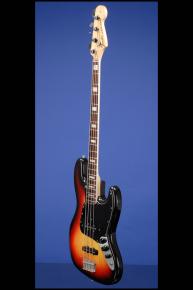A Natural Jazzer!
This near mint thirty-four year old Jazz Bass weighs just 10.10 lbs. and has a narrow nut width (compared to the Precision Bass) of just over 1 1/2 inches and a scale length of 34 inches. Solid alder body, one-piece fretted maple neck with a very comfortable medium profile. Rosewood fretboard with 20 original frets, inlaid pearloid block position markers and single white binding. Headstock with large type "C" decal under the finish (with "Fender" in black with gold trim, four patent numbers and "Jazz Bass" in black below, and with "Offset Contour Body Patented" at the ball end of the headstock). Single round string tree. Individual Fender tuners with registered trademark above the Fender logo and cloverleaf metal buttons. Three-bolt neck plate with 'Micro Adjustment' and the Fender backward "F" logo and above that the serial number "698232". Two eight-polepiece pickups with outputs of 8.70 and 7.38k. Three-layer (black/white/black) plastic pickguard with ten screws. Three controls (two volume blend controls, one for each pickup, and one master tone) and jack socket, all on metal plate adjoining pickguard. Black plastic knobs with white markings. With the original thumb rest on the bass side of pickguard. Combined four-saddle standard single-grooved bridge/tailpiece . With both original bass pickup and bridge pickup covers. The green neck stamp is indiscernible. The potentiometers are all stamped "1377607" (CTS, February 1976). This guitar is in near mint condition, with only a few very small surface marks and one single line of finish checking on the back. Housed in its original Fender black hardshell case with red plush lining (9.00).
"The second version Jazz Bass got a three screw fixing as well as the micro tilt system in the seventies. The bridge/tailpiece which had been in nickel plated steel was henceforth in chrome plated steel like most other parts, in June 1971 the truss rod was done in the Bullet configuration (patented in 1970) with adjustment being done at the peghead whereas previously it had to be done with a Phillips head screw driver at the neck's end facing the body. This feature makes it easy to adjust the alignment of the neck and body. There is no need for any disassembly, shims or even loosening of the strings" (Klaus Blasquiz. The Fender Bass. pp. 18-19).
"After the introduction of the Jazzmaster in 1958, Fender needed an upscale model to augment the bass line. In 1960, Leo's new Jazz Bass borrowed the offset waist and part of the name from the Jazzmaster. It also featured a narrower neck width, which was faster playing than the Precision Bass" (J.W. Black and Albert Molinaro, The Fender Bass, p. 25).
The Jazz Bass was the second electric bass guitar created by Leo Fender. The Jazz Bass is distinct from the Precision Bass in that its tone is brighter and richer in the mid-range with less emphasis on the basic harmonic. Because of this, many bass players who want to be more 'forward' in the mix, including smaller bands such as three-piece power trios, prefer the Jazz Bass. The sound of the Fender Jazz Bass has been fundamental in the development of signature sounds in many musical genres, such as funk, disco, blues, metal and jazz fusion.
Translate:









